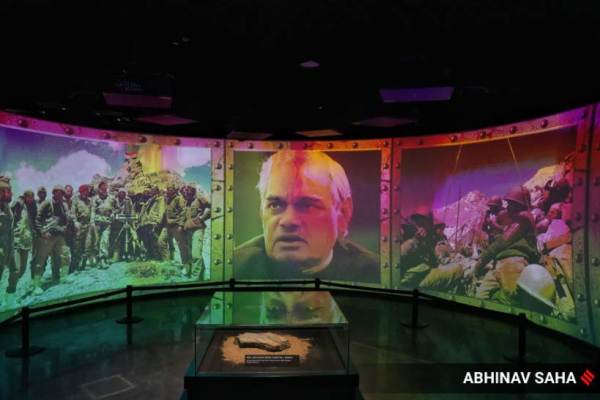
Concept and controversy
The idea of a museum dedicated to India’s Prime Ministers was mooted in 2016. The Congress opposed the idea, since Teen Murti Estate was Nehru’s residence, which was later turned into a memorial to the first Prime Minister. Manmohan Singh wrote to Modi, expressing concern over the “agenda” to “change the nature and character” of Nehru Memorial Museum and Library (NMML) and the Teen Murti complex.
NMML officials say Teen Murti Estate, where Nehru lived for 16 years, is the natural home for the Pradhanmantri Sangrahalaya because of the continuity the site represents.
The Rs 270-crore project was approved in 2018, and NMML was appointed the nodal agency for the project in May 2019. Delays in civil works and content and curation issues, as well as disruptions caused by pandemic lockdowns resulted in the project missing the completion deadline of October 2020.
 The idea of a museum dedicated to India’s Prime Ministers was mooted in 2016. (Express Photo: Abhinav Saha)
The idea of a museum dedicated to India’s Prime Ministers was mooted in 2016. (Express Photo: Abhinav Saha)
Erstwhile Nehru Museum
Story continues below this ad
What used to be the Nehru Museum has been integrated with the new building. The Nehru Museum is now designated as Block I of the Prime Ministers’ Museum, and has been technologically upgraded. A number of gifts Nehru received from all over the world, which had not been put on display so far, have been exhibited in the toshakhana on the first floor of the renovated Block I.
Two new galleries — Constitution Gallery and India at Independence: British Legacy — have been added on the ground floor.
The new building
The top of the new museum — Block II of the complex — is built in the shape of the Ashok Chakra, from where visitors walk down to the various galleries. The ground floor has galleries dedicated to Gulzarilal Nanda, Lal Bahadur Shastri, Indira Gandhi, P V Narasimha Rao, H D Deve Gowda, I K Gujral, Atal Bihari Vajpayee, and Manmohan Singh.
Story continues below this ad
The first floor has galleries dedicated to Rajiv Gandhi, V P Singh, Chandra Shekhar, Morarji Desai, and Charan Singh. The guiding principle has been to recognise the contribution of all Prime Ministers in a non-partisan manner, officials said.
The Shastri gallery highlights his role in the Green Revolution and the Indo-Pak war of 1965. The Indira gallery highlights India’s role in the liberation of Bangladesh, and the nationalisation of banks. The Vajpayee gallery celebrates him as a great parliamentarian and orator, and highlights India’s victory in the Kargil War and the Pokhran nuclear tests. The economic reforms of the early 1990s and the civil nuclear deal with the US are highlighted among Manmohan Singh’s contributions.
 What used to be the Nehru Museum has been integrated with the new building. (Express Photo: Abhinav Saha)
What used to be the Nehru Museum has been integrated with the new building. (Express Photo: Abhinav Saha)
Memorabilia, displays
Over the last two years, families of all former Prime Ministers were requested to give some of their personal items for display. Shastri’s family gave his charkha, badminton racquet and some letters; Morarji’s family donated his copy of the Bhagavad Gita, his Gandhi topi, pen, and rudraksh mala.
Story continues below this ad
Some handwritten diaries of Chandra Shekhar are on display, as are Vajpayee’s Bharat Ratna medal, spectacles, wristwatch, and some letters.
No new personal items have been added in the Indira and Rajiv galleries.
The displays comprise photographs, speeches, video clips, newspaper interviews, and some original writings. These were collected from Doordarshan, Films Division, Sansad TV, the Ministry of Defence, Indian and foreign media houses and news agencies, and the toshakhana of the Ministry of External Affairs.
Families were requested for valuable information about the leaders; most of this content has been acquired on perpetual licence.
Story continues below this ad
 The 10,491-sq-m museum, built at a final cost of Rs 306 crore, has 43 galleries, and can accommodate 4,000 visitors at a time. (Express Photo: Abhinav Saha)
The 10,491-sq-m museum, built at a final cost of Rs 306 crore, has 43 galleries, and can accommodate 4,000 visitors at a time. (Express Photo: Abhinav Saha)
Virtual engagement
The 10,491-sq-m museum, built at a final cost of Rs 306 crore, has 43 galleries, and can accommodate 4,000 visitors at a time. There is a ‘Time Machine’ to transport visitors into the past, and an engagement zone, ‘Anubhuti’, offers a walk with the hologram of any Prime Minister, a picture with the PMs, or a letter ‘signed’ by them.
The museum makes extensive use of virtual reality, augmented reality, holograms, and audio-visual elements. A levitating emblem is the centrepiece of the reception zone, and ‘Glimpses of the Future’ on the ground floor allows visitors to be virtually part of future projects.
Newsletter | Click to get the day’s best explainers in your inbox



 The idea of a museum dedicated to India’s Prime Ministers was mooted in 2016. (Express Photo: Abhinav Saha)
The idea of a museum dedicated to India’s Prime Ministers was mooted in 2016. (Express Photo: Abhinav Saha) What used to be the Nehru Museum has been integrated with the new building. (Express Photo: Abhinav Saha)
What used to be the Nehru Museum has been integrated with the new building. (Express Photo: Abhinav Saha) The 10,491-sq-m museum, built at a final cost of Rs 306 crore, has 43 galleries, and can accommodate 4,000 visitors at a time. (Express Photo: Abhinav Saha)
The 10,491-sq-m museum, built at a final cost of Rs 306 crore, has 43 galleries, and can accommodate 4,000 visitors at a time. (Express Photo: Abhinav Saha)




































